
Dog tag is an informal but common term for a specific type of identification tag worn by military personnel. The tags' primary use is for the identification of casualties; they have information about the individual written on them, including identification and essential basic medical information such as blood type and history of inoculations. They often indicate a religious preference as well.

The Roman legion, the largest military unit of the Roman army, comprised 4,200 infantry and 300 equites (cavalry) in the period of the Roman Republic and 5,600 infantry and 200 auxilia in the period of the Roman Empire.

Lucius Septimius Severus was a Roman politician who served as emperor from 193 to 211. He was born in Leptis Magna in the Roman province of Africa. As a young man he advanced through the customary succession of offices under the reigns of Marcus Aurelius and Commodus. Severus seized power after the death of the emperor Pertinax in 193 during the Year of the Five Emperors.

Titus Caesar Vespasianus was Roman emperor from 79 to 81. A member of the Flavian dynasty, Titus succeeded his father Vespasian upon his death.
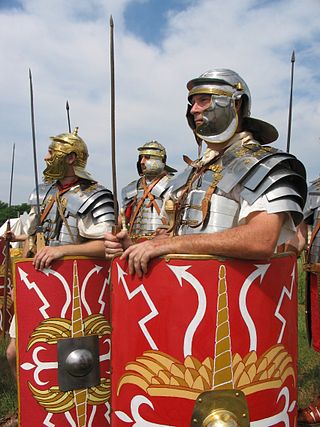
The Roman legionary was a professional heavy infantryman of the Roman army. These soldiers would conquer and defend the territories of ancient Rome during the late Republic and Principate eras, alongside auxiliary and cavalry detachments. At its height, Roman legionaries were viewed as the foremost fighting force in the Roman world, with commentators such as Vegetius praising their fighting effectiveness centuries after the classical Roman legionary disappeared.
A cohort was a standard tactical military unit of a Roman legion. Although the standard size changed with time and situation, it was generally composed of 480 soldiers. A cohort is considered to be the equivalent of a modern military battalion. The cohort replaced the maniple. From the late second century BC and until the middle of the third century AD, ten cohorts made up a legion. Cohorts were named "first cohort", "second cohort", etc. The first cohort consisted of experienced legionaries, while the legionaries in the tenth cohort were less experienced.

The Roman army was the armed forces deployed by the Romans throughout the duration of Ancient Rome, from the Roman Kingdom to the Roman Republic and the Roman Empire, and its medieval continuation, the Eastern Roman Empire. It is thus a term that may span approximately 2,205 years, during which the Roman armed forces underwent numerous permutations in size, composition, organisation, equipment and tactics, while conserving a core of lasting traditions.
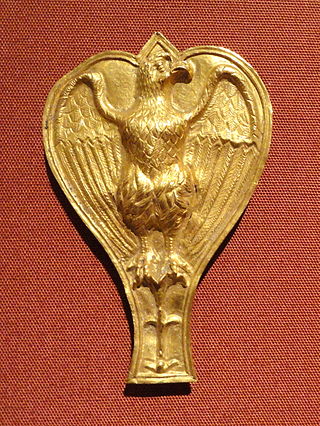
An aquila was a prominent symbol used in ancient Rome, especially as the standard of a Roman legion. A legionary known as an aquilifer, the "eagle-bearer", carried this standard. Each legion carried one eagle.
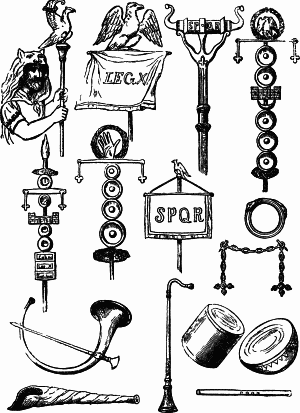
Roman military personal equipment was produced in large numbers to established patterns, and used in an established manner. These standard patterns and uses were called the res militaris or disciplina. Its regular practice during the Roman Republic and Roman Empire led to military excellence and victory. The equipment gave the Romans a very distinct advantage over their barbarian enemies, especially so in the case of armour. This does not mean that every Roman soldier had better equipment than the richer men among his opponents. Roman equipment was not of a better quality than that used by the majority of Rome's adversaries. Other historians and writers have stated that the Roman army's need for large quantities of "mass produced" equipment after the so-called "Marian Reforms" and subsequent civil wars led to a decline in the quality of Roman equipment compared to the earlier Republican era:
The production of these kinds of helmets of Italic tradition decreased in quality because of the demands of equipping huge armies, especially during civil wars...The bad quality of these helmets is recorded by the sources describing how sometimes they were covered by wicker protections, like those of Pompeius' soldiers during the siege of Dyrrachium in 48 BC, which were seriously damaged by the missiles of Caesar's slingers and archers.
It would appear that armour quality suffered at times when mass production methods were being used to meet the increased demand which was very high the reduced size cuirasses would also have been quicker and cheaper to produce, which may have been a deciding factor at times of financial crisis, or where large bodies of men were required to be mobilized at short notice, possibly reflected in the poor-quality, mass produced iron helmets of Imperial Italic type C, as found, for example, in the River Po at Cremona, associated with the Civil Wars of AD 69 AD; Russell Robinson, 1975, 67
Up until then, the quality of helmets had been fairly consistent and the bowls well decorated and finished. However, after the Marian Reforms, with their resultant influx of the poorest citizens into the army, there must inevitably have been a massive demand for cheaper equipment, a situation which can only have been exacerbated by the Civil Wars...
Maximilian of Tebessa, also known as Maximilian of Numidia, was a Christian saint and martyr, whose feast day is observed on 12 March. Born in AD 274, the son of Fabius Victor, an official connected to the Roman army, Maximilian was obliged to enlist at the age of 21. He is noted as the earliest recorded conscientious objector, although it is believed that other Christians at the time also refused military service and were executed.
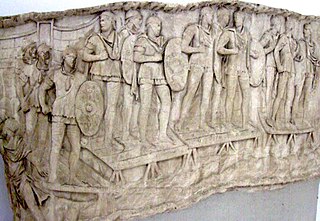
The auxilia were introduced as non-citizen troops attached to the citizen legions by Augustus after his reorganisation of the Imperial Roman army from 27 BC. By the 2nd century, the Auxilia contained the same number of infantry as the legions and, in addition, provided almost all of the Roman army's cavalry and more specialised troops. The auxilia thus represented three-fifths of Rome's regular land forces at that time. Like their legionary counterparts, auxiliary recruits were mostly volunteers, not conscripts.
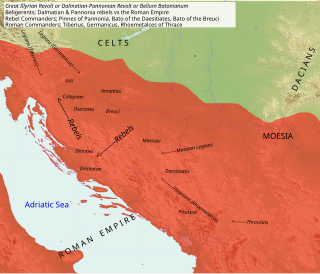
The Bellum Batonianum was a military conflict fought in the Roman province of Illyricum in the 1st century AD, in which an alliance of native peoples of the two regions of Illyricum, Dalmatia and Pannonia, revolted against the Romans. The rebellion began among native peoples who had been recruited as auxiliary troops for the Roman army. They were led by Bato the Daesitiate, a chieftain of the Daesitiatae in the central part of present-day Bosnia and Herzegovina, and were later joined by the Breuci, a tribe in Pannonia led by Bato the Breucian. Many other tribes in Illyria also joined the revolt.
The structural history of the Roman military concerns the major transformations in the organization and constitution of ancient Rome's armed forces, "the most effective and long-lived military institution known to history." At the highest level of structure, the forces were split into the Roman army and the Roman navy, although these two branches were less distinct than in many modern national defense forces. Within the top levels of both army and navy, structural changes occurred as a result of both positive military reform and organic structural evolution. These changes can be divided into four distinct phases.
As with most other military forces the Roman military adopted an extensive list of decorations for military gallantry and likewise a range of punishments for military transgressions.

In modern scholarship, the "late" period of the Roman army begins with the accession of the Emperor Diocletian in AD 284, and ends in 480 with the death of Julius Nepos, being roughly coterminous with the Dominate. During the period 395–476, the army of the Roman Empire's western half progressively disintegrated, while its counterpart in the East, known as the East Roman army remained largely intact in size and structure until the reign of Justinian I.
Legio VI Hispana may have been a legion of the Imperial Roman army. Only a few records attesting a "VI Hispana" were known in 2015. Seyrig (1923) argued that this unit was created in AD 68 and disappeared before 197. Another theory is that VI Hispana was created after 197 and was destroyed in the turmoil of the Empire's Third Century Crisis.

The Imperial Roman army was the military land force of the Roman Empire from 27 BC to 476 AD, and the final incarnation in the long history of the Roman army. This period is sometimes split into the Principate and the Dominate (284–476) periods.












